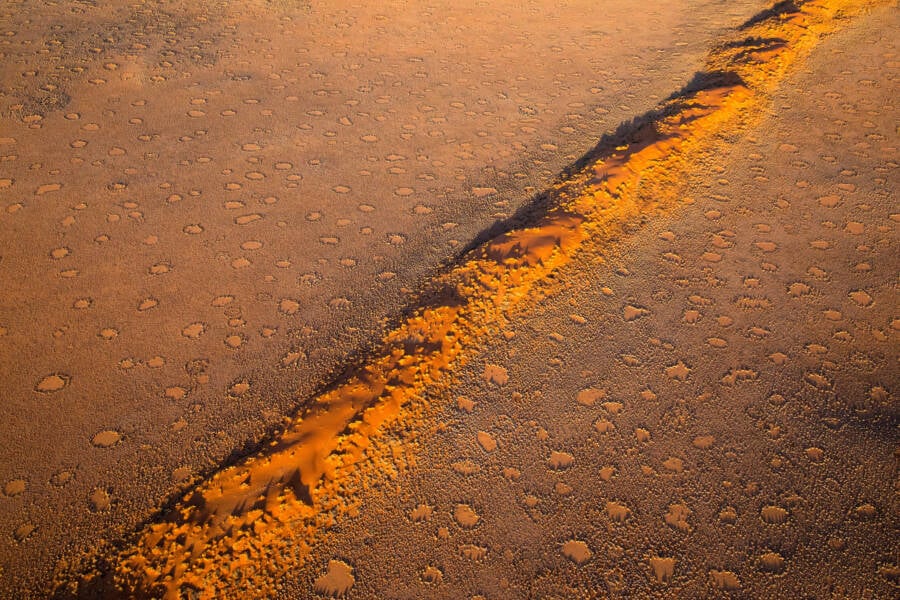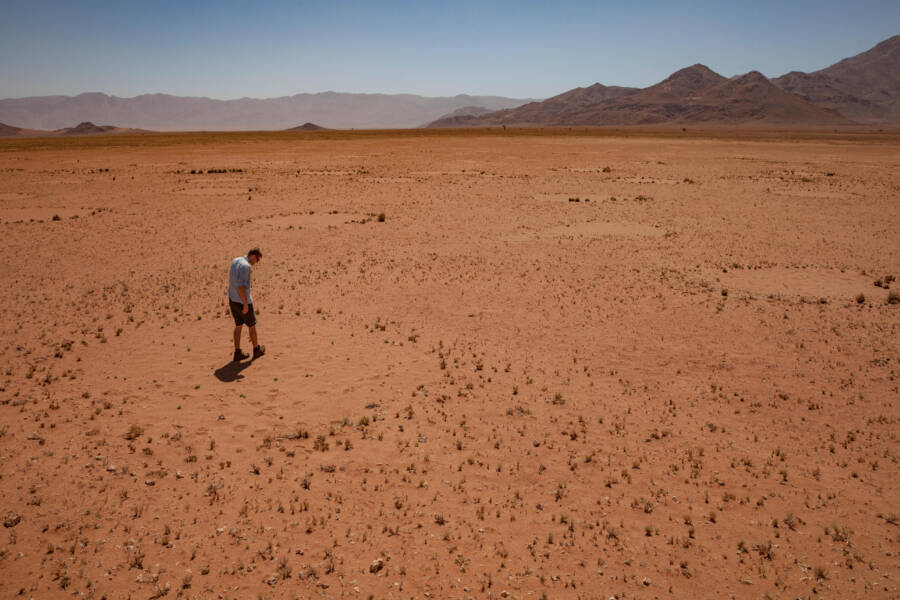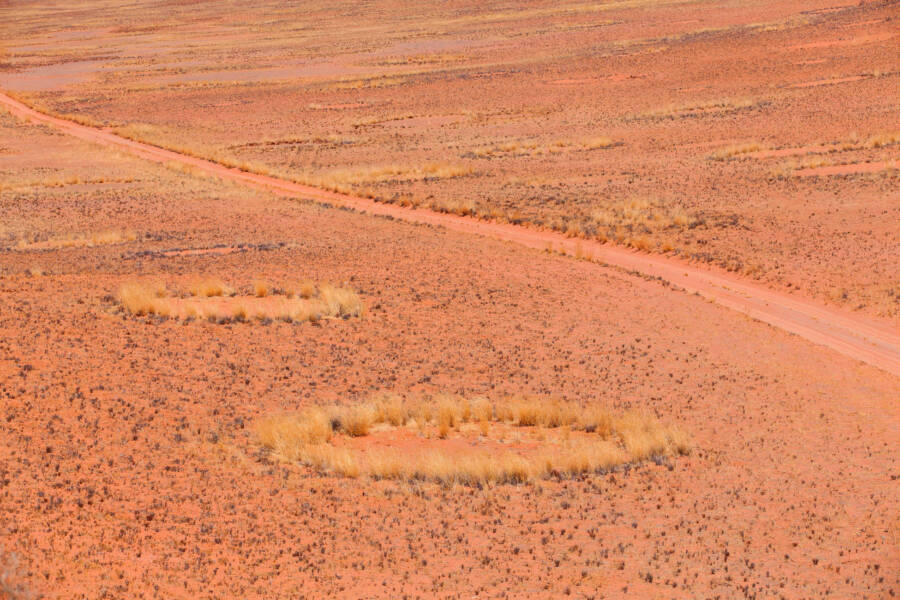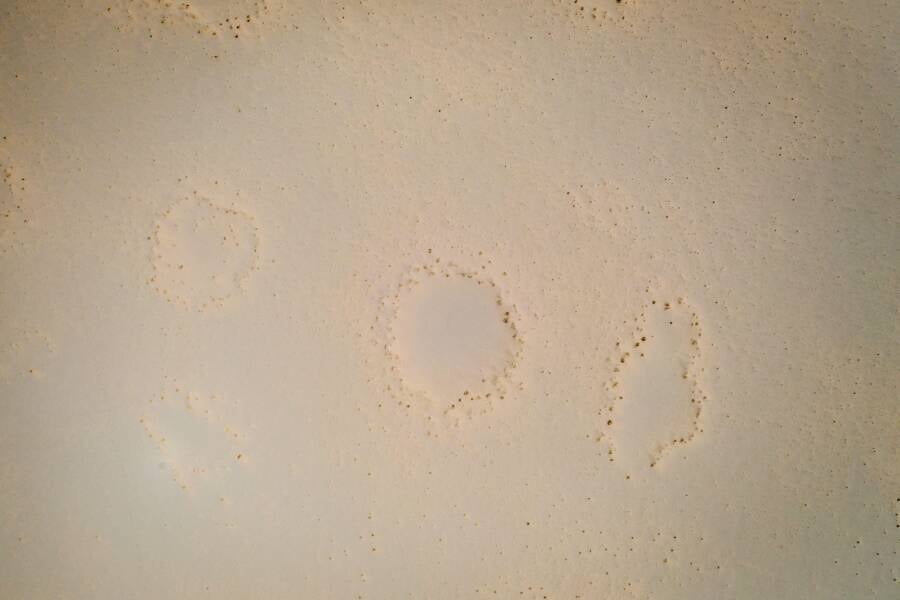Mysterious rings devoid of vegetation that can be found around the world, fairy circles have baffled researchers for decades — now, they have an additional 263 sites to analyze.

Nature in Stock/Alamy Stock PhotoFairy circles are round, dry patches of earth surrounded by vegetation and typically only found in parts of Africa and Australia.
Fairy circles have long been a baffling mystery for researchers. They dot the landscapes of Australia and Africa — most commonly, the Namib Desert, which stretches from Angola to northern South Africa.
Researchers have put forth a number of theories on how these seemingly mystical circles form, to little avail.
Of course, the name itself invokes a sense of mystery and intrigue. While researchers have sought a scientific explanation for these enigmatic fairy circles, the Himba people who live in the Namib Desert region have found an explanation through their own folklore and beliefs.
According to the New York Times, the circles were thought to have been made by their “original ancestor, Mukuru” — fairy circles are the “footprints of the gods.” It’s an interesting explanation, but a recent discovery changes the situation quite a bit.
In September 2023, researchers found that fairy circles are significantly more widespread than previously believed, with new evidence showing that these enigmatic circles may appear at as many as 263 sites in 15 countries across three continents, further deepening the mystery.
What Are Fairy Circles?

Monika Hrdinova/Dembinsky Photo Associates/Alamy Stock PhotoAn aerial view of the Namib desert, dotted with fairy circles and arid grass formations.
For decades, researchers have tried to discover the cause of the strange circles that litter the deserts of Namibia and the Australian Outback. The circles, round areas of barren dirt, can collect in groups that extend for miles.
Numerous theories have been put forth, but no consensus has ever been reached. The two prevailing views, however, are that these enigmatic rings are created by termites or plants competing over limited water.
And despite claims of finally “solving” the mystery, no one has actually done so.
A study published in 2022 seemed to give the water-related hypothesis a clear lead, with authors acknowledging that the Namib Desert is one of the driest regions in the world, usually only receiving a few inches of rain each year.
Earlier studies attributed the strange, barren rings to natural ecosystem engineering by a particular species of sand termites, Psammotermes allocerus.
These two theories largely dominated the debate for decades. Meanwhile, some of the Himba people who call the region home have attributed the appearance of these circles to their gods. Or, as some tour guides will say, maybe they’re made by a dragon that lives in cracks beneath the earth. This dragon’s breath, they say, is toxic and kills the vegetation on the surface, forming the rings.
Naturally, scientists have not been satisfied with this explanation. And now, new information has added another layer to this ongoing mystery.
These Mysterious Rings Are Much More Widespread Than Previously Believed
Recently, the New York Times reported that a new study of satellite imagery from around the world had revealed the prominence of fairy circles from various sites across the globe.

Nature Picture Library/Alamy Stock PhotoA researcher standing in the middle of a fairy circle found in the Namib Desert.
“We discovered fairy circle locations in many other places that we didn’t know existed before, because most of the work on this topic has been carried out in just two countries, Namibia and Australia,” said Fernando Maestre, an ecologist at the University of Alicante in Spain and an author of the study.
According to the new study, fairy-circle-like patterns have been shown to occur in up to 263 sites in 15 countries across three continents — incredibly widespread compared to previous findings, which only identified them in two distinct regions.
The researchers’ interest was first piqued when data scientist Emilio Guirado noticed patterns in Niger on Google Earth that seemed to be fairy circles. After that, he began to wonder if these mysterious patterns appeared in other dryland habitats.

blickwinkel/Alamy Stock PhotoFairy circles in Nimibia during the dry season.
They then trained a pattern-recognition model with images of known fairy circles from Namibia and Australia and applied it to satellite imagery of 575,000 two-and-a-half-acre plots of dryland habitat — which comprises around 41 percent of the Earth’s land surface.
In all, they found that a small percentage of these dryland habitats possibly contained fairy circle patterns: roughly 193 square miles. They manually confirmed the model’s identification of these fairy circles by looking at the satellite imagery themselves.
The findings allowed researchers to create a profile of the types of habitats where fairy circles, or patterns similar to them, are likely to occur: hot, arid environments with sandy soil low in nitrogen that only receive four to 12 inches of rainfall annually.
According to Maestre, statistical tests confirmed that “the patterns we have found are exactly the same patterns as what people have found in Namibia and Australia.”
The Debate Around Fairy Circles Continues
Careful not to upset the larger scientific community, Maestre and the team only described their new findings as “fairy-circle-like vegetation patterns,” as the actual term “fairy circle” is a hotly debated topic. It also, unfortunately, lacks a proper standard definition.
“Unfortunately, the only guardians of the term ‘fairy circle’ are self-appointed,” ecophysiologist Michael Cramer, who was not involved with the study, told the Times. “Getting agreement on the naming of fairy circles would probably require the establishment of a Fairy Circle Convention on Nomenclature, which seems unlikely.”

Edwin Remsberg/Alamy Stock PhotoScientists have not formed a consensus on what defines a fairy circle.
Still, despite Maestre’s team treading carefully, they have received pushback from other members of the scientific community. German ecologist Stephan Getzin, for example, said the new study “dilutes the term ‘fairy circle’ and it ignores the definition of fairy circles in the process.”
Getzin and his colleagues argued in a 2021 study that true varieties occur in a grid-like pattern with “extremely strong” ordering — a pattern not matched by the patterns found by Maestre and his colleagues.
Maestre argued that Getzin’s own definition is “not backed up by the whole of the scientific community working with fairy circles,” and therefore, it “does not undermine our findings in any way.”
In any case, researchers now have at least 263 new sites to explore, which might offer additional insight into how fairy circles are formed — whether termites, a lack of water, or some other factor like climate change or ecosystem degradation.
After reading about the ongoing mystery surrounding fairy circles, learn about Scotland’s Fairy Glen, the valley so magical it was said to be made by fairies. Or, dive into a brief history of the world’s coolest crop circles.





